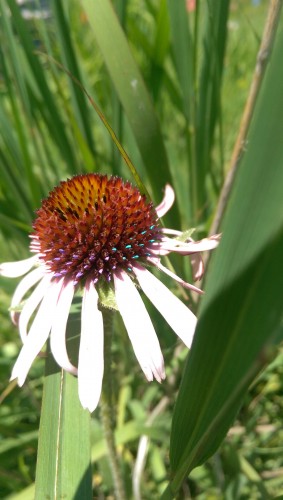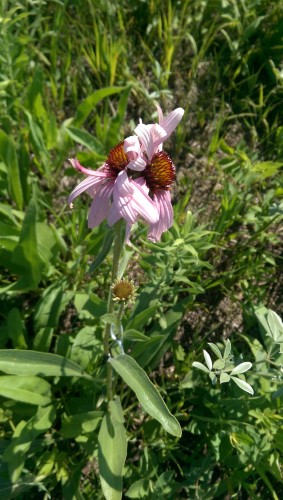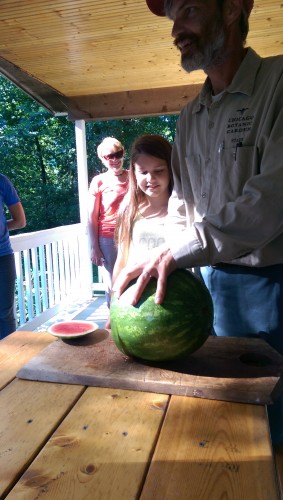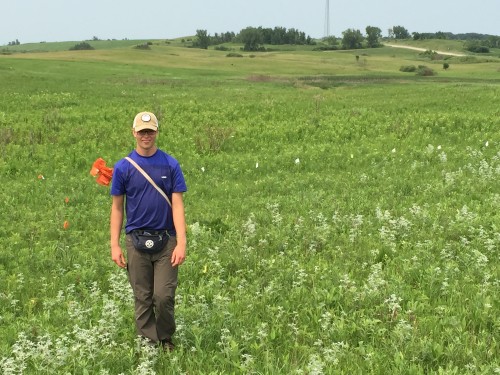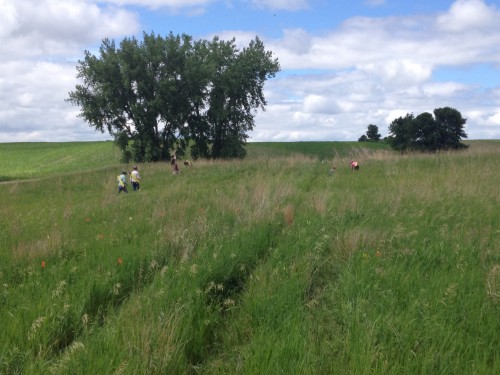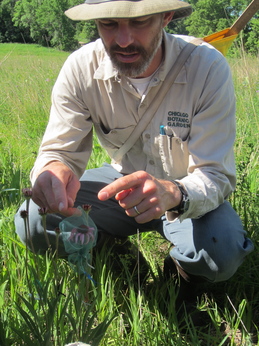|
|
Today when we arrived at the Hjelm house it was only 50 degrees! Brrrrrr! We were also down to a team of six following Ben’s last day on Friday and Stuart and Gretel heading back to Illinois over the weekend. (Abby was gone for her senior pictures). With so few people we got off to a quick start, because we knew we would need all the time we could get to get as much done with fewer crew members.
Our skeleton crew headed out to p2 to continue measuring that we started last Thursday. It was slow going but, having gotten through the thickest of the flowering plants on Thursday it was faster than it could have been. It is always windy at p2 since it is on top of a hill but today was especially windy and cold, most crew members could barely feel their hands which made entering data on the visor a challenge. We managed to get by, completing 20 rows before heading in for lunch.
After a warm up with some hot chocolate at lunch we headed out to do various things in the afternoon. Danny, Amy, Gina and I went to harvest heads in the remnants based on a sampling method that Danny and Amy developed. Ali and Katherine rechecked some funky measurements in p1 and harvested a few of the heads that will be used in the q3 experiment (exciting!). Amy and I went to a ton of different remnants and encountered a few problems, like at Stevens approach were most of the heads were mowed. The highlight of our afternoon was at Aanenson where we met a really friendly cow named Willow! she came up to the fence and let us pet her. Her not-so-outgoing friends were hesitant and we didn’t pet them. Willow even gave Amy’s hand a lick, “it felt really weird” said Amy shortly after the licking. Sadly we could not spend all afternoon with our new friend and went to continue harvesting.
 Willow the cow investigates her new, soon-to-be friends, Will and Amy  Willow’s friends investigate us from afar, clearly not as outgoing or cool as Willow.
The days and weeks are starting to fly by as we get into the busy part of the summer. Nearing the end of July, it seems like we’re hovering right around the peak of the flowering season for Echinacea angustifolia. In addition to keeping up with the phenology for our flowers (roughly a couple thousand across our remnants alone!), we’re also making timely progress on independent projects and getting important work done on the q3 experiment.
We got off to a quick start this morning sending half the crew out to do phenology at a handful of sites while Danny and Amy continued their work assessing compatibility across remnant flowers and still a few others collected pollen at Staffanson for q3. While phenology is proving to be quite the time commitment right now, we’re slowly (and satisfyingly) starting to be able to check the “Done flowering” box for more and more of our flowers. The flowering season is tapering off much faster than I had expected!
 A cross-pollinator’s eye view of a well-organized team carrying out crosses in p1. The bright and breezy afternoon had most of the team out in p1 doing pollen crosses for q3. Stuart debuted a new system for keeping us organized in the field as we share, swap, switch, and track down the right vials of sire pollen to be applied to the p1 dams. While the fits of wind that persisted for much of the afternoon were a nice way to cool down, it was not very much appreciated when the breeze swept away the valuable bits of pollen we were trying to apply to our flowers!
The day ended with a visit from some of the parents of the crew members and local science teachers (these two groups actually had quite a bit of overlap). These visits were timed excellently for our guests to appreciate the Echinacea in all their peak flowering glory.
 Bagged and painted Echinacea ready to be cross-pollinated.
 My beautiful bracts!  Ben, Gina, & Matt practice precise painting Today was another successful day with the team! We had a morning filled with phenology at half of the sites and later everyone divided to get many things accomplished. After lunch, some of us practiced painting the bracts of Echinacea; this wasn’t too hard, it was actually very pleasant. Using toothpicks, we had to be sure to paint the tops of bracts as well as the bottom while making sure not to get paint on the florets or apply too much.
 I see absolutely nothing wrong here. Here, Lea and I were at p2 collecting phenology data in the afternoon. There are 80 rows in this plot and it took us almost the whole day to get the job done! I’m from the south and it honestly takes a lot for me to confess that a place is hot, but the way the sun was blazing today, I wasn’t sure if I’d make it out of the prairie to deliver this flog post to you! It was so “warm” today I was seeing double headed Echinacea…….. sheesh.
To conclude a week full of accomplishments, Stuart sliced up the best watermelon ever. One shouldn’t argue this watermelon’s caliber; I know this was the best watermelon ever because it replenished all the sense I lost in p2 today. I’d say that everyone else enjoyed this glorious melon as well! Today was a good Friday!
 Watermelon after work!
After our day was delayed by rain, we started off the morning with remnant phenology. Groups headed to the landfill site, Staffanson Prairie Preserve and other remnants. We shot several points at Landfill, East Elk Lake Road and Around Landfill. We got a lot done in the morning!
We had a late lunch and then headed back out into the field. Three of us went to Hegg Lake and put twist ties on flowering plants in Jennifer’s plot. there is a ton of flowers out there and we are almost a quarter of the way done! I will be doing a project involving the plants in Jennifer’s plot (p2) looking at the heritability of flowering phenology in Echinacea angustifolia. It is great to have a lot of flowers in p2!

Here is Ben after twist tying about 70 flowering Echinacea heads in p2, Thanks for the help Ben!

Experimental plot 1 (P1) encompasses 11 different experiments originally planted with a total of 10673 Echinacea individuals. These experiments include long-term studies designed to compare the fitness of Echinacea from different remnant populations (“EA from remnants in P1”), examine the effects of inbreeding on plant fitness (“INB” and “INB2”), and explore other genetic properties of Echinacea such as trait heritability (“qGen”). In 2014, Team Echinacea measured plant traits for the 5409 Echinacea plants that remain alive and followed the daily phenology of 567 flowering heads. Echinacea began producing florets on July 1 and continued flowering in P1 until August 24. The data collected in 2014 will allow us to estimate the heritability of various traits and assess the lifetime fitness of plants from the numerous experiments.
|
Experiment |
Year planted |
# alive |
# flowering |
# planted |
| 1 |
1996 |
1996 |
314 |
115 |
650 |
| 2 |
1997 |
1997 |
270 |
57 |
600 |
| 3 |
1998 |
1998 |
32 |
3 |
375 |
| 4 |
1999 |
1999 |
542 |
106 |
888 |
| 5 |
1999S |
1999 |
297 |
37 |
418 |
| 6 |
SPP |
2001 |
318 |
14 |
797 |
| 7 |
Inbreeding |
2001 |
221 |
15 |
557 |
| 8 |
2001 |
2001 |
170 |
11 |
350 |
| 9 |
Monica 2003 |
2003 |
28 |
3 |
100 |
| 10 |
qGen |
2003 |
2501 |
122 |
4468 |
| 11 |
INB2 |
2006 |
716 |
41 |
1470 |
Start year: 1996
Location: experimental plot 1
Products:
Overlaps with: aphid addition exclusion, Pamela’s functional traits, pollen longevity, pollen addition exclusion
Today marked the first weekday of the peak week of flowering for Echinacea. We are working on phenology at all the remnants as will as P1. Several flowers are already on their last day of flowering. Despite the cold and blustery conditions of today the team did crosses for the compatibility project at Loeffler’s Corner and set up the project at East Elk Lake Road. Cam and I worked on my exhaustive crossing project at Yellow Orchid Hill. We weren’t able to collect pollen and cross until after lunch, but fortunately the pollen was not blown away by the wind! Tomorrow will be more phenology and compatibility!
The last flowering plant in CG1 put out its last anthers today (August 27, 2012). It had been flowering over a week longer than any of the other plants we monitor! This marks the end of the flowering season for Team Echinacea, but we’ve still got lots of work left to do!
Last week was a busy and fun one for Team Echinacea 2012; no two days were the same. We wrapped up some of the first summer projects and started to transition into the second phase of the summer. We completed evaluating the recruitment plots, began to record their GPS locations, conducted demography and phenology observations in the common garden, and perhaps most notably, completed round one of seeding searches with the west (and recently burned) section of Staffanson prairie with help from Amy Dykstra, who came to visit on Friday. In addition to all the progress made on the long-term projects, we also spent multiple rainy mornings working on our individual research projects, the proposals for which have been recently, or will soon be posted here on the flog.  Stuart Instructs us on the proper field techniques for cross-pollination, pollinator exclusion, and painting flowers so we can keep track of what we’ve just done. Stuart Instructs us on the proper field techniques for cross-pollination, pollinator exclusion, and painting flowers so we can keep track of what we’ve just done.
After a short weekend, we started up working again this Monday with a morning dedicated to our independent projects, time which we all used to get out in the field and get our hands dirty. Ruth stopped by today and lent a hand and some very welcome advise, and joined the crew in the afternoon to do some weeding in the common garden. We clipped, pulled, and trimmed Buckthorn, Ash saplings, Birdsfoot Trefoil, Sweet Clover, and Sumac.
Hello all! A lot has happened since my last post, so here is a brief update!
After returning to school with my phenology data and experimental seed heads in the fall of 2011, I began work on my senior thesis using that data as a foundation. In April of this year I defended my thesis, “Flowering Phenology and Seed Set in Fragmented Populations of the Prairie Plant Echinacea angustifolia” and was awarded Distinction by my committee! Stuart and I continued to work on my data after my defense and are planning to continue the project and potentially incorporate data from this summer in the hopes of publishing it! Here are some of the very interesting results that we’ve gotten so far:
> aggregate(ss ~ nndist + pdtime, data = mm, mean)
nndist pdtime ss
1 far early 0.1637403
2 near early 0.2690535
3 far late 0.2947009
4 near late 0.1802392
We found that there’s a relationship between seed set (ss), peak flowering date (pdtime), AND distance to the 6th nearest neighbor (nndist). Seed set was higher in plants that had a combination of close 6th nearest neighbor (near) and early peak flowering date or far 6th nearest neighbor (far) and late flowering date. Very interesting!
(table is categorical and matches glm model which looks at pd & nn6 as continuous)
If anyone has any questions, is interested in continuing this exciting project this summer, or would like a copy of my thesis, feel free to contact me! (Amber Zahler at ambermzahler@gmail.com)
We found 147 flowering plants in Jennifer’s Phenology Experiment during a thorough, but not exhaustive, search on Friday. Most of these plants have buds only and will start shedding pollen later. I posted a map of locations of all plants to flower this year.
 Click on thumbnail to see a larger map. Click on thumbnail to see a larger map.
Jennifer planted this experiment to investigate heritability of flowering timing (phenology) in spring 2006.
Last year eight plants flowered and about 2700 plants were alive. Read about measuring last year.
Assuming that almost all of those plants are still alive and that we didn’t find all the flowering plants, then about 6% of surviving plants will flower this year (>147/2700).
For kicks, I made maps of the paths of data enterers. We usually worked in pairs and used one person’s PDA to enter data. Here are the paths…
Josh D’s visor, Amber E’s, Nicholas G’s visor, Gretel K’s visor, Lee R’s visor, Callin S’s, Stuart W’s visor, Maria W’s visor, Amber Z’s visor. For the record Katherine M’s visor had only one record and we didn’t use Karen T’s visor.
|
|





